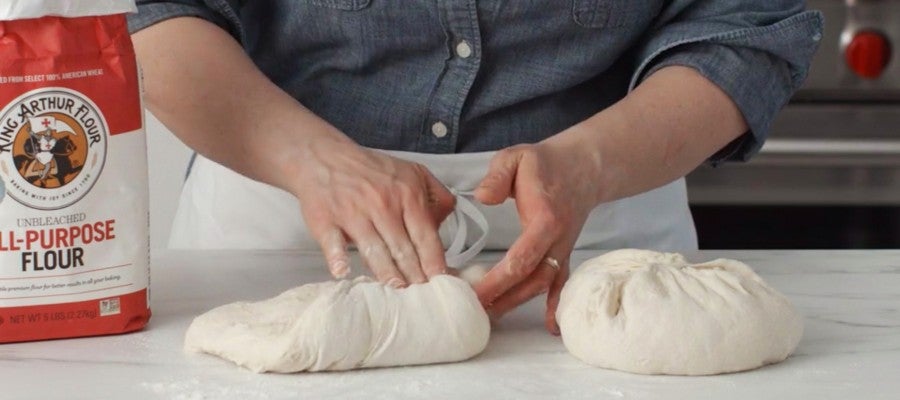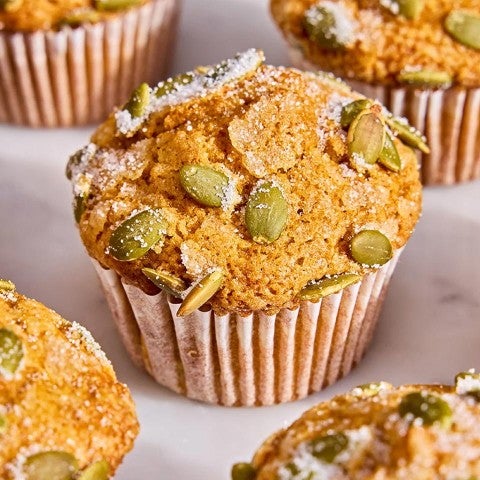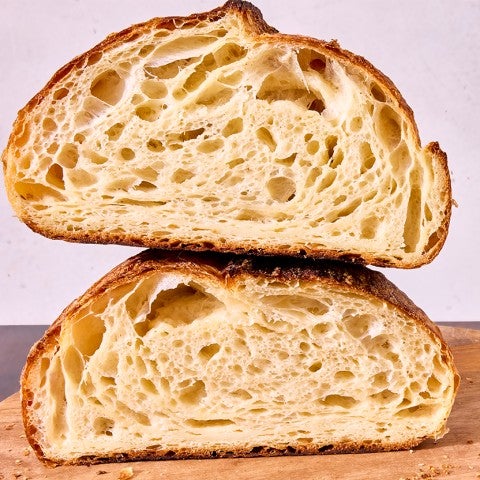Day 1

- Combine 113g (a generous 1 cup) pumpernickel or 113g (1 cup) whole wheat flour with 113g (1/2 cup) room-temperature (68°F-70°F) water in a non-reactive container. Glass, crockery, stainless steel, or food-grade plastic all work fine for this. Make sure the container is large enough to hold your starter as it grows; we recommend at least 1-quart capacity.
- Stir everything together thoroughly; make sure there's no dry flour anywhere. Cover the container loosely and let the mixture sit at warm room temperature (about 70°F) for 24 hours. A note about room temperature: The colder the environment, the more slowly your starter will grow. If the normal temperature in your home is below 68°F, we suggest finding a warmer spot to develop your starter. For instance, try setting the starter atop your water heater, refrigerator, or another appliance that might generate ambient heat. Your turned-off oven — with the light turned on — is also a good choice.
Day 2

- You may see no activity at all in the first 24 hours, or you may see a bit of growth or bubbling. Either way, discard half of the starter (113g, about 1/2 cup); you'll be left with about 113g (1/2 cup) starter. Add to this 113g (a scant 1 cup) King Arthur Unbleached All-Purpose Flour (hereafter simply called "flour"), and 113g (1/2 cup) cool water (if your house is warm); or lukewarm water (if it's cold).
- Mix well, cover, and let the mixture rest at room temperature for 24 hours.
Day 3
- By the third day, you'll likely see some activity — bubbling; a fresh, fruity aroma, and some evidence of expansion. It's now time to begin two feedings daily, as evenly spaced as your schedule allows. For each feeding, weigh out 113g starter (a generous 1/2 cup once it's thoroughly stirred down). Discard any remaining starter.
- Add 113g flour and 113g water to the 113g starter. Mix the starter, flour, and water, cover, and let the mixture rest at room temperature for approximately 12 hours before repeating.
Day 4 + 5
- On Day 4, weigh out 113g starter, and discard any remaining starter. Repeat feeding routine from Day 3.
- On Day 5, weigh out 113g starter, and discard any remaining starter. Once again, add 113g flour and 113g water to the starter. Mix, cover, and let it rest for 12 hours. By the end of day 5, the starter should have at least doubled in volume. You'll see lots of bubbles; there may be some little "rivulets" on the surface, full of finer bubbles. Also, the starter should have a tangy aroma — pleasingly acidic, but not overpowering.
Day 6 + 7

- If your starter hasn't risen much and isn't showing lots of bubbles, repeat discarding and feeding every 12 hours on day 6, and day 7, if necessary — as long as it takes to create a vigorous (risen, bubbly) starter. Conditions vary so widely that 7 days can actually be too little. The key is to watch for a dramatic and consistent rise in the container — at least doubling between 6 and 8 hours after feeding. This could be 7 days or less after you begin, or it could be up to a couple of weeks. Watch for this benchmark, rather than watching the calendar.
- Once the starter is ready, give it one last feeding: the standard 113g water + 113g flour. If you plan to continue following this guide and bake our Naturally Leavened Sourdough Bread, however, you'll need to bulk up your starter. Discard all but 189g, then feed it 189g of water and 189g of flour. However much you've fed it, let the starter rest at room temperature for 6 to 8 hours; it should be active, with bubbles breaking the surface.

- Remove the amount of starter you need for your recipe — for our crock, jar, or whatever you'd like to store it in long-term; the container doesn't need to be airtight. Feed this reserved starter with 113g flour and 113g water and let it rest at room temperature for several hours, to get going, before refrigerating it.
- Store this starter in the refrigerator, and feed it regularly; we recommend feeding it with 113g flour and 113g water once a week.
How to tell when your starter is ready to use
The multi-day process involved in creating your own sourdough starter from scratch results in a strong starter that's active, bubbly, and ready to raise and flavor bread dough without the addition of domestic (manufactured) yeast. How do you know when your starter is ready to use (i.e., ripe)?
Your new starter is ready to bake with when it's reliably becoming very bubbly and doubling in size within 6 to 8 hours of feeding. (This is why it's useful to feed your starter in a clear, straight-sided container, so it's easy to track its upward progress.) Ripe starter will be viscous, not thin; and if you taste a tiny bit, it will be nicely balanced between rich flavor and acidity.
Why discard so much starter?
It seems so wasteful... Unless you discard starter at some point, you'll quickly end up with a very large container of starter. Also, keeping the volume down offers the yeast more food to eat each time you feed it; it's not fighting with quite so many other little yeast cells to get enough to eat. Finally, the feeding process works well when the ratio of starter-to-flour-to-water is 1:1:1 — equal parts, by weight, existing starter, added flour, and added water. Some bakers prefer different ratios, but this is a good place to start.
You don't have to actually discard starter if you don't want to; you can give it to a friend, or use it to bake. There are quite a few recipes on our site using "discard" starter, including pizza crust, pretzels, waffles, and even chocolate cake. See our Sourdough Discard Recipe Collection for some of our favorites.
Common problems and what to do
What if I forget to feed it? When sourdough starter is neglected — left on the counter or in the refrigerator for extended periods without being fed — the yeast and bacteria run out of food, and their populations gradually decline. Basically, your starter is dying a slow death; the longer it's left unfed, the more difficult it will be to revive it and get it ready for baking. Feeding your starter regularly can prevent this situation. And also cure it: If you do happen to forget your starter for a while, a series of regular feedings should restore its health.
What's the "right" aroma? Sourdough starter should smell sharply sour but "clean," with no overtones of spoilage, or any oddly chemical smell (think acetone). While the aroma of sourdough may make you draw back simply from its strength, it shouldn't be distasteful.
When to throw it out: When your starter is neglected for an extended period, the liquid on top tends to turn from clear to dark-colored. That's OK; simply stir the liquid back into the starter and feed it the meal it's desperately craving. However, if your starter shows visible signs of mold, or an orange or pink tint/streak, or smells — well, putrid — throw it out; it's been invaded by harmful microorganisms, and it's time to start over.

Next: Bake
At last! Your starter looks healthy and vigorous. Now it’s time for the main event — let’s bake some bread!
Get started








